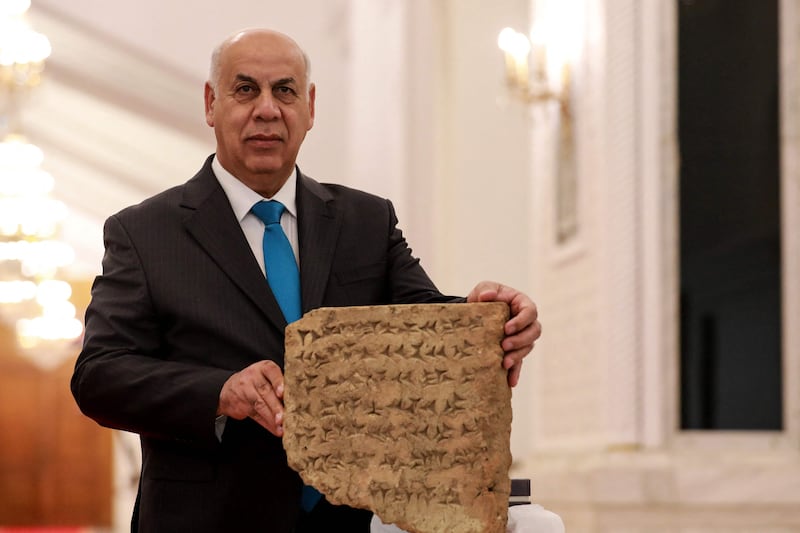Iraq has revealed a stone tablet that has been handed over by Italy after being seized by police there nearly 40 years ago.
The 2,800-year-old tablet is unique, Iraq’s culture ministry said, because of the completeness of its cuneiform writing in the Babylonian alphabet.
Significantly larger than many other clay tablets found in Iraq, it also bears the insignia of Shalmaneser III, the Assyrian king who ruled the Nimrod region – close to present-day Mosul – from 858 to 823BC.

Iraq has been trying to recover looted and stolen artefacts for years and recent efforts have been increasingly successful.
Many artefacts, including ancient stone tablets, were smuggled out of the country in the chaos following the US-led invasion in 2003, when many archaeological sites were left unguarded.
Other smuggling dates back to the 1990s, when Iraq suffered extreme poverty due to harsh international sanctions, leading to a crime wave that extended to smuggling heritage.
In 2018, US arts and crafts chain store Hobby Lobby was fined $3 million after US investigators found that more than 3,000 clay tablets and seals had been smuggled out of the country in operations beginning in 2010.
Since then, thousands more items from around the world have been recovered. In 2021, Iraqi and US authorities secured the return of 17,000 ancient objects, including the so-called Gilgamesh Dream Tablet, to Iraq. The 3,600-year-old tablet contains a section of the ancient Akkadian poem, the Epic of Gilgamesh.
The circumstances surrounding the latest tablet to be returned remain unclear, but the Italian authorities handed it over to Iraqi President Abdul Latif Rashid during a visit to Bologna in the past week.
“I would like to thank the Italian officials for their efforts and co-operation in bringing back this piece,” Mr Rashid said, during a ceremony on Sunday at a Baghdad presidential palace to hand the artefact over to the national museum.
National museum plan
The tablet arrived in Italy in the 1980s, where it was seized by police, said Laith Majid Hussein, director of Baghdad's council of antiquities and heritage.
Iraq's Culture Minister Ahmed Fakak Al Badrani said the circumstances behind its discovery were unclear.
“Perhaps [it was found] during archaeological excavations or during work on the Mosul dam,” he said. The dam, built in the 1980s, is Iraq's biggest.
Modern Iraq's territory is the cradle of the Sumerian, Akkadian, Babylonian and Assyrian civilisations, to which humanity owes writing and the first cities.
“We will continue to work to recover all the archaeological pieces of Iraqi history from abroad,” said the Iraqi President.
“We want to make the national Iraq Museum one of the best museums in the world, and we will work to do so.”
In May, New York prosecutor Alvin Bragg announced the return of two ancient sculptures to Iraq: a limestone Mesopotamian elephant and an alabaster Sumerian bull from the old city of Uruk.
The figurines, stolen during the Gulf War, were smuggled into New York in the late 1990s, according to the prosecutor's office.
The bull was part of the private collection of Shelby White, a billionaire philanthropist and Met trustee.






